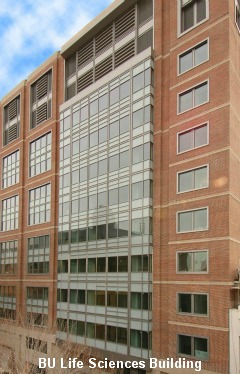Boston University's (BU) Life Sciences Building was built directly over the busy I-90 MassPike, yet needed to maintain a quiet interior environment. Wausau's market managers have access to dozens of acoustic test results for various frame-glass combinations, to help in selecting and specifying products - for BU, Wausau HP-Wall with triple insulating glass.
The Basics
The decibel (dB) is a logarithmic measure of sound pressure level. Because decibels are logarithmic, they cannot be added, subtracted or multiplied with ordinary arithmetic. Small differences of less than +/-3dB in sound pressure level or transmission loss are barely perceptible.
Pitch or frequency is expressed in Hertz (Hz) or cycles per second. Low frequency noises carry much more energy than high frequency sounds, and therefore, are more difficult to absorb. For this reason, low frequency sound also "carries" a longer distance outdoors. In general, glass performs much better at higher frequencies.
 Transmission Loss(TL) is a measure of a material or assembly's sound attenuation at a specific frequency. For STC or OITC testing, a Transmission Loss Curve is generated over the frequency range that can be perceived by the human ear, to provide a quantification of overall acoustical performance.
Transmission Loss(TL) is a measure of a material or assembly's sound attenuation at a specific frequency. For STC or OITC testing, a Transmission Loss Curve is generated over the frequency range that can be perceived by the human ear, to provide a quantification of overall acoustical performance.
Sound Transmission Class (STC) is a single-number rating system for acoustical performance, developed primarily for the typical interior noise spectrum. STC is the most commonly specified measure of acoustical performance - "higher is better."
Outdoor-Indoor Transmission Class (OITC) is a single-number rating system for acoustical performance, developed primarily for the typical exterior noise spectrum. TLs are measured at somewhat lower frequencies than in STC testing.
Acoustical consultants determine required performance levels by starting from exterior sound intensity data. This is a complex process, requiring consideration of the noise source (rail vs. traffic vs. aircraft), time-weighted exposure averages, and attenuation due to distance. Interior occupancy plays a major part in determining the required STC, OITC, or octave band transmission losses.
System Design
Improvement in acoustical performance is achieved by adding glazing mass, increasing air space, and improving damping by the addition of a laminated interlayer. Of course, maintaining an air-tight assembly to reduce "flanking" noise is critical, especially at high frequency.
Adding another layer of glass at the expense of air space does not typically help much, i.e. a 1½" triple insulating glass (IG) unit will perform similarly to a 1½" double IG unit. Incremental improvement in higher frequencies can sometimes be attained by "unbalancing" the insulated unit, e.g. using a 3/16" inner lite with a ¼" outer lite.
The addition of sound-absorbing foam between the lites of a dual-glazed system can improve STC 1 to 2 points, but only if high-frequency noise transmission is the controlling factor in STC calculations.
For any given air-tight, rigidly supported glass-air space combination, frame design makes almost no difference in acoustical performance.
Performance Summary
|
|
STC Range |
OITC Range |
|
Systems using 1" IG without laminated layers: |
29 to 34 |
25 to 29 |
|
Systems using IG with one lite laminated: |
33 to 38 |
28 to 32 |
|
Dual glazed systems with access doors: |
34 to 42 |
31 to 33 |
|
Triple glazed systems with access doors: |
41 to 47 |
32 to 40 |
The location of laminated lites (interior or exterior) within the assembly makes no significant difference in acoustical performance, nor does heat strengthening or tempering.
"Whole Window" Results

Glass-only test results often are not based on rigidly supported lites, and will be several STC points higher than "whole window" results. There is no dependable way to adjust these glass numbers to predict window performance to any degree of accuracy.
To discuss proper system selection in detail, Wausau's market managers are available as architectural support resources, and can be reached at education@wausauwindow.com, healthcare@wausauwindow.com, or government@wausauwindow.com.